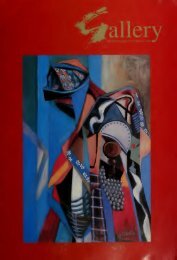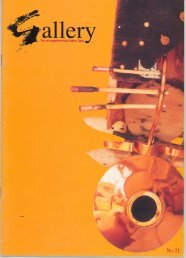Gallery : the art magazine from Gallery Delta
Gallery : the art magazine from Gallery Delta
Gallery : the art magazine from Gallery Delta
You also want an ePaper? Increase the reach of your titles
YUMPU automatically turns print PDFs into web optimized ePapers that Google loves.
Early examples of work by <strong>the</strong> <strong>art</strong>ists of <strong>the</strong> National <strong>Gallery</strong><br />
Workshop School demonstrate <strong>the</strong> vigour of that genre which is<br />
p<strong>art</strong>icular to <strong>the</strong> nor<strong>the</strong>rn half of <strong>the</strong> country. Women's <strong>art</strong>-making is<br />
represented by <strong>the</strong>ir traditional materials of clay and textiles; <strong>the</strong>ir<br />
subjects are those p<strong>art</strong>icular to <strong>the</strong>mselves. Innovative use of found<br />
materials abounds in sculpture made <strong>from</strong> wire, tins and rags. Works<br />
such as Zephania Tshuma's No Way To Go, Morris Tendai's The<br />
Trouble With Money and <strong>the</strong> Tashinga Group'sViolence Against<br />
Women testify to pertinent social issues.<br />
Zimbabwe stone sculptors' work is acknowledged but is situated<br />
within <strong>the</strong> broader framework. Artists such as Thomas<br />
Mukarombwa and Nicholas Mukomberanwa, who have<br />
achieved international recognition share <strong>the</strong> stage with<br />
unknown urban painters and anonymous rural sculptors.<br />
Marvellous Mangena has achieved notable success with his<br />
heightened naturalism. Mtshongoyo Dancers marries <strong>the</strong> past<br />
with <strong>the</strong> present as <strong>the</strong> traditional ceremonial dance is performed<br />
in a modem football stadium.<br />
Givas Mashiri is a self-taught painter and sculptor who lives in<br />
Mufakose, a high density suburb of Harare. He owns and runs a tuck-<br />
shop which is also his studio. His painting Mufakose Shopping<br />
Centre is a romanticised view of a place familiar to him. The details<br />
of <strong>the</strong> shops, <strong>the</strong> people, <strong>the</strong> dustbins and <strong>the</strong> bushes are all given <strong>the</strong><br />
same uncompromising attention.<br />
Atalia Nyoni was one of <strong>the</strong> first tapestry weavers to be trained at<br />
Cold Comfort Farm outside Harare. TTiis tapestry Beer To Fetch Rain<br />
At The Matopos tells of <strong>the</strong> events she remembers as a child when<br />
beer was brewed and <strong>the</strong> people danced to call <strong>the</strong> rain. There is a<br />
large cave in <strong>the</strong> Matopos Hills near Bulawayo that is a sacred place<br />
and home of <strong>the</strong> Great Spirit.<br />
Enezia Nyazorwe was a member of <strong>the</strong><br />
Weya Training Centre <strong>art</strong> project near<br />
Macheke. Her painting A Story About<br />
Termites is in <strong>the</strong> decorative colourful Weya<br />
style of flat images in a crowded shallow<br />
space. It tells a fantasy story of villagers<br />
who try to ga<strong>the</strong>r termites to eat but are<br />
fooled by clever dancing dogs.<br />
Joram Mariga was one of <strong>the</strong> earliest stone<br />
sculptors to be encouraged by Frank<br />
McEwen, <strong>the</strong> first director of <strong>the</strong> National<br />
<strong>Gallery</strong> in Harare. His small sculpture<br />
Uncle Holding Baby shows <strong>the</strong> uncle<br />
holding <strong>the</strong> baby awkwardly upside-down<br />
behind his back. It is said to be <strong>the</strong> way to<br />
drive out <strong>the</strong> nightmares of a small child.<br />
Nehanda 's Defiance, an early work by<br />
Tapfuma Gutsa, concerns Mbuya Nehanda<br />
who is revered in Zimbabwe as being <strong>the</strong><br />
leader of <strong>the</strong> first war of liberation. She<br />
defied <strong>the</strong> settler authorities, calling on <strong>the</strong><br />
people to rebel.<br />
No Way To Go (see illustration on Contents page) is by Zephania<br />
Tshuma who lives in Matabeleland. His work is well known for its<br />
pithy social comment.<br />
This exhibition is a challenge to Africa to assert its own values. As<br />
<strong>the</strong> Dadaists and <strong>the</strong>ir followers challenged <strong>the</strong> nature of '<strong>art</strong>', so too<br />
can <strong>the</strong>ir concept of <strong>art</strong> be challenged by a return to figuration,<br />
narrative and <strong>the</strong> traditional ways and means of painting and sculp-<br />
ture. There is something infinitely precious to be lost by genuflecting<br />
to <strong>the</strong> worst gods of contemporary <strong>art</strong>. We could lose our sense of<br />
identity and our willingness to communicate with each o<strong>the</strong>r in terms<br />
we can all understand.<br />
Joram Mariga,<br />
Uncle Holding Baby, 1957,<br />
29 X 20cm, green serpentine<br />
Atalia Nyoni, Beer to Fetch<br />
Rain at <strong>the</strong> Matopos, 1995,<br />
90 X 80cm, tapestry







